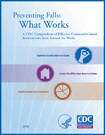Preventing Falls: What Works
 That’s the title of a new CDC book, which presents “specific interventions that have rigorous scientific evidence of effectiveness” in lowering the risk of falls among the elderly.
That’s the title of a new CDC book, which presents “specific interventions that have rigorous scientific evidence of effectiveness” in lowering the risk of falls among the elderly.
It’s intended for public health practitioners, senior service providers, and others who wish to implement fall prevention programs. But I think it’s also valuable for family and caregivers who want to know what can be accomplished to reduce the risk of falls by their loved ones.
Here’s a synopsis of the benefits with the best-studied strategies.
Exercise-based
- Stay Safe, Stay Active
- 40% less likely to fall.
- One-third less likely to suffer a fall-related injury.
- The Otago Exercise Program
- Fall rate reduced 35%.
- Participants aged 80 years and older who had fallen in the previous year showed the greatest benefit.
- Tai Chi: Moving for Better Balance
- Risk of falling decreased 55%.
- Australian Group Exercise Program
- Fall rate was 22% lower among participants.
- 31% lower among those who fell in the previous year.
- Veterans Affairs Group Exercise Program
- Participants were two-thirds less likely to fall.
- Simplified Tai Chi
- Risk of falling was cut almost in half.
Home modifications
- Home Visits by an Occupational Therapist
- Fall rates reduced one-third but only among participants who had one or more falls in the year before the study.
- Falls-HIT (Home Intervention Team) Program
- Fall rate was reduced 31%.
- Most effective (37%) among those who experienced two or more falls in the previous year.
Multifaceted interventions
- Stepping On
- Fall rate was reduced about 30%.
- Especially effective for men — almost two-thirds reduction.
- PROFET (Prevention of Falls in the Elderly Trial)
- 60% less likely to fall once.
- 67% less likely to fall repeatedly.
- The NoFalls Intervention
- Used alone, it reduced the fall rate 20%.
- Falls were reduced further when vision improvement or home hazard reduction was combined with exercise.
- The SAFE Health Behavior and Exercise Intervention
- Participants were 15% less likely to fall.
- Men showed the greatest benefit.
- Yale FICSIT (Frailty and Injuries: Cooperative Studies of Intervention Techniques)
- Participants were 30% less likely to fall.
- A Multifactorial Program
- Participants were 10% less likely to fall.
- 5% less likely to have an injurious fall.
The bottom line?
The CDC has compiled an excellent and readable resource. It also describes how the studies were selected, the details of each study, and sources for more information about the studies and resulting programs.
3/7/08 09:38 JR